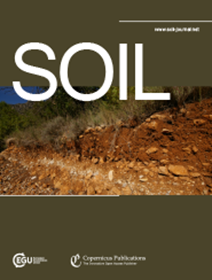Drivers and CO2 flux budgets in a Sahelian Faidherbia albida agro-silvo-pastoral parkland: Insights from continuous high-frequency soil chamber measurements and Eddy Covariance
IF 4.3
2区 农林科学
Q1 SOIL SCIENCE
引用次数: 0
Abstract
Abstract. Agroforestry systems — combining trees with crops and/or livestock — are increasingly promoted as sustainable and climate-resilient land-use strategies. Despite their widespread presence in the Sahel, experimental data on their potential as carbon sinks are scarce. This study presents a full-year, high-frequency dataset of CO2 fluxes in a Sahelian agro-silvo-pastoral parkland dominated by F. albida, located in Senegal’s groundnut basin. CO2 fluxes were continuously measured using automated static chambers, allowing the quantification of soil and crop respiration (Rch), gross primary production (GPPch), and net carbon exchange (FCO2ch) under both full sun and shaded (under tree canopies) environments. Seasonal patterns of CO2 fluxes were similar in both environments, with peaks during the rainy season. Rch and GPPch were significantly higher under tree canopies, indicating a ‘fertile island’ effect. CO2 flux variability was primarily driven by soil moisture and leaf area index. Chamber-based GPP estimates closely matched those from Eddy Covariance measurements. On an annual scale, F. albida trees contributed approximately 50 % of total ecosystem GPP, with a carbon use efficiency of 0.48. Net annual CO2 exchange was estimated at −1.4 ± 0.02 and −1.8 ± 0.01 Mg C-CO2 ha⁻¹ using chamber and Eddy Covariance methods, respectively. These findings underscore the role of F. albida-based agroforestry systems as effective carbon sinks in Sahelian landscapes, supporting their potential contribution to climate change mitigation.萨赫勒地区大绿农林牧区的驱动因素和CO2通量预算:来自连续高频土壤室测量和涡旋相关方差的见解
摘要。农林复合系统——将树木与作物和/或牲畜结合起来——作为可持续和适应气候变化的土地利用战略日益得到推广。尽管它们在萨赫勒地区广泛存在,但关于它们作为碳汇潜力的实验数据却很少。本研究提出了一个位于塞内加尔花生盆地的萨赫勒地区以albida为主导的农林业-牧区公园的全年高频二氧化碳通量数据集。使用自动化静态室连续测量CO2通量,从而可以在完全阳光和遮荫(树冠下)环境下量化土壤和作物呼吸(Rch)、总初级生产量(GPPch)和净碳交换(FCO2ch)。两种环境中CO2通量的季节模式相似,在雨季达到峰值。Rch和GPPch在树冠下显著较高,表明存在“肥沃岛”效应。CO2通量变异主要受土壤湿度和叶面积指数驱动。基于腔室的GPP估计与涡流协方差测量结果非常吻合。在年尺度上,杉木对生态系统总GPP的贡献约为50%,碳利用效率为0.48。使用室内法和涡流相关法估计,年二氧化碳净交换量分别为- 1.4±0.02和- 1.8±0.01 Mg C-CO2 ha(⁻¹)。这些发现强调了以云杉为基础的农林业系统在萨赫勒地区景观中作为有效碳汇的作用,支持了它们对减缓气候变化的潜在贡献。
本文章由计算机程序翻译,如有差异,请以英文原文为准。
求助全文
约1分钟内获得全文
求助全文
来源期刊

Soil
Agricultural and Biological Sciences-Soil Science
CiteScore
10.80
自引率
2.90%
发文量
44
审稿时长
30 weeks
期刊介绍:
SOIL is an international scientific journal dedicated to the publication and discussion of high-quality research in the field of soil system sciences.
SOIL is at the interface between the atmosphere, lithosphere, hydrosphere, and biosphere. SOIL publishes scientific research that contributes to understanding the soil system and its interaction with humans and the entire Earth system. The scope of the journal includes all topics that fall within the study of soil science as a discipline, with an emphasis on studies that integrate soil science with other sciences (hydrology, agronomy, socio-economics, health sciences, atmospheric sciences, etc.).
 求助内容:
求助内容: 应助结果提醒方式:
应助结果提醒方式:


